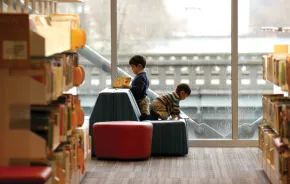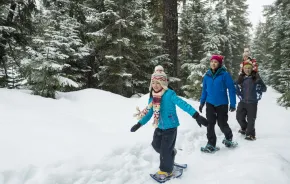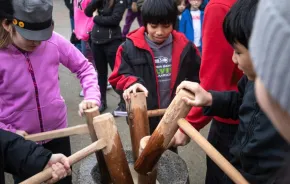They watch Polar Express and Thomas the Tank Engine, sing “I’ve Been Working on the Railroad” and build wooden tracks. But how many children have actually ridden a train?
 Across the Northwest, hundreds of engineers, firemen and uniformed conductors are bringing rail travel to life — and you and your kids are invited to come along.
Across the Northwest, hundreds of engineers, firemen and uniformed conductors are bringing rail travel to life — and you and your kids are invited to come along.
“If you want a genuine historical experience, come ride the Lake Whatcom Railway,” says manager Frank Culp. Its century-old train cars have wrought-iron baggage shelves, brass hand-pump fire extinguishers and reupholstered 1940s seating. Kids will love riding the open platforms in back or trying out the stools in the 1925 coffee shop. A 1940 diesel engine pulls the train to a meadow with picnic tables and a small waterfall. Here, visitors ride a 100-year-old handcar, once used for rail repairs. It’s surprisingly easy to propel; four kids abreast can get it moving. Kids can also climb into the engine’s cab to examine the controls or pose for pictures.
After the 90-minute round trip, visitors can admire a 1907 steam engine with an ear-splitting whistle, or drive to Lake Whatcom to ride the speeder (a tiny automated railcar) if volunteers are available. “I can be the engineer and the conductor, drive the speeder and run the coffee shop,” says Culp, “but I can’t do it all at the same time.”
The 1890 Snoqualmie Depot is “the oldest continually operating passenger station in Washington,” says visitor services manager James Stackey. It’s also the main depot for the Snoqualmie Valley Railroad.
A diesel electric engine pulls four passenger cars built between 1912 and 1916, including a unique wood-sided car. The train stops at Snoqualmie Falls (best seen from the right side of the first three cars) and the North Bend Depot. Visitors can board at either depot. During the 70-minute round trip, volunteer conductors describe the train’s history and furnishings: Some of the lamps and wood panels are original, while the benches are from Ernst (that iconic, long-gone hardware store).
After you stop at the Snoqualmie Depot, take a few minutes to explore the small museum there, with its reconstructed ticket office, switchboards and other exhibits, as well as historic train engines and cars.
“There’s nothing like driving steam,” says retired train engineer Jim Abney, who commutes 150 miles from Oregon to volunteer for the Mount Rainier Scenic Railroad (MRSR). Even newcomers feel the allure of the great engine as it starts chugging, with steam billowing out both sides.
The train follows an eight-mile route that crosses Puget Sound’s largest wooden trestle. On clear days, watch for snow-capped Mount Rainier. After a half-hour stop to switch the engine, the train returns to Mineral Lake, where passengers play horseshoes, hike a short trail through the woods or eat at the picnic tables. If you’re having too much fun to leave, you can catch a later train.
During stops, the engineers show off the engine. It takes two people to run: an engineer to drive, and a fireman to monitor the fire and the steam pressure. No coal shoveling is required; these engines burn used motor oil. Engine enthusiasts pay extra to ride in the cab (ages 10 and older). To see MRSR’s other historic engines, ask the conductor or at ticket office for the Shop Tour.
If you’re interested in modern train travel, try Amtrak, says Bellevue Boys and Girls Club teacher Julie Hetland. Her preschoolers love the adjustable seats, the viewing room above the snack car and the toy room. Ride from Seattle to Tacoma and take the free light rail downtown to visit museums, or enjoy views of Puget Sound riding north to Everett.
Whether you’re fans of Thomas, model trains or grand adventures, your family will love riding the rails. All aboard!
Loralee Leavitt loves writing and exploring with her family.
GO
- Lake Whatcom Railway (Wickersham)
- Mount Rainier Scenic Railroad (Mineral)
- Snoqualmie Valley Railroad (Snoqualmie/North Bend)
- Amtrak
This article originally appeared in the June, 2009 issue of ParentMap.











